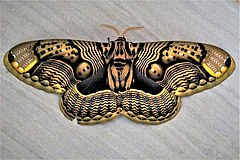Brahmaea wallichii
| Règne | Animalia |
|---|---|
| Embranchement | Arthropoda |
| Classe | Insecta |
| Ordre | Lepidoptera |
| Super-famille | Bombycoidea |
| Famille | Brahmaeidae |
| Genre | Brahmaea |
- Bombyx wallichii Gray, 1831
- Brahmaea conchifera Butler, 1880[1]
- Brahmophthalma wallichii
Brahmaea wallichii est une des plus grandes espèces de papillons de nuit de la famille des Brahmaeidae. On le trouve dans le nord de l'Inde, au Népal, au Bhoutan, en Birmanie, en Chine, à Taïwan et au Japon. Son envergure est d'environ 90 à 160 mm[2].
Apparence
[modifier | modifier le code]Ce papillon de nuit a des taches oculaires bien développées sur les ailes antérieures et un motif caractéristique de rayures brun-noir. Les marges brun clair de ses ailes postérieures présentent de petites taches blanches triangulaires. Son corps robuste est également noir et marron, avec des rayures brun-orange caractéristiques[2].
Étymologie
[modifier | modifier le code]L'espèce porte le nom du botaniste Nathaniel Wallich (1786-1854)[3].
Comportement
[modifier | modifier le code]Ses chenilles se nourrissent de Frêne commun, de troènes et de lilas commun. En captivité, elles se nourrissent également de sureau[2]. Elles sont capables de neutraliser les toxines végétales produites par les troènes[4].
Les papillons adultes sont actifs la nuit ; pendant la journée, ils se reposent les ailes déployées sur le tronc des arbres ou sur le sol. Lorsqu'il est dérangé, le papillon ne s'envole pas, mais bat violemment des ailes[2].

Habitat
[modifier | modifier le code]L'espèce a pour habitat à la fois les forêts tropicales et tempérées[2].
Sous-espèces
[modifier | modifier le code]- Brahmaea wallichii wallichii
- Brahmaea wallichii insulata Inoue, 1984 (Taïwan)
- Brahmaea wallichii saifulica de Freina, 1983 (ouest de l'Himalaya)
Notes et références
[modifier | modifier le code]- (en) Markku Savela, « Genus Brahmaea », funet.fi, (consulté le )
- (nl) David J. Carter, Vlinders (translated book), Baarn, First (translated), , 216 p. (ISBN 90-246-4923-4)
- (en) Gray, J.E. (1831) : « Description of a new species of Bombyx from Nepaul, discovered by Dr. Wallich ». The Zoological Miscellany, Londres, vol. 1, p. 39 (lire en ligne).
- (en) Kotaro Konno, Sachiko Okada et Chikara Hirayama, « Selective secretion of free glycine, a neutralizer against a plant defense chemical, in the digestive juice of the privet moth larvae », Journal of Insect Physiology, vol. 47, no 12, , p. 1451–1457 (PMID 12770151, DOI 10.1016/S0022-1910(01)00135-4)
Liens externes
[modifier | modifier le code]- Ressources relatives au vivant :
Text is available under the CC BY-SA 4.0 license; additional terms may apply.
Images, videos and audio are available under their respective licenses.

